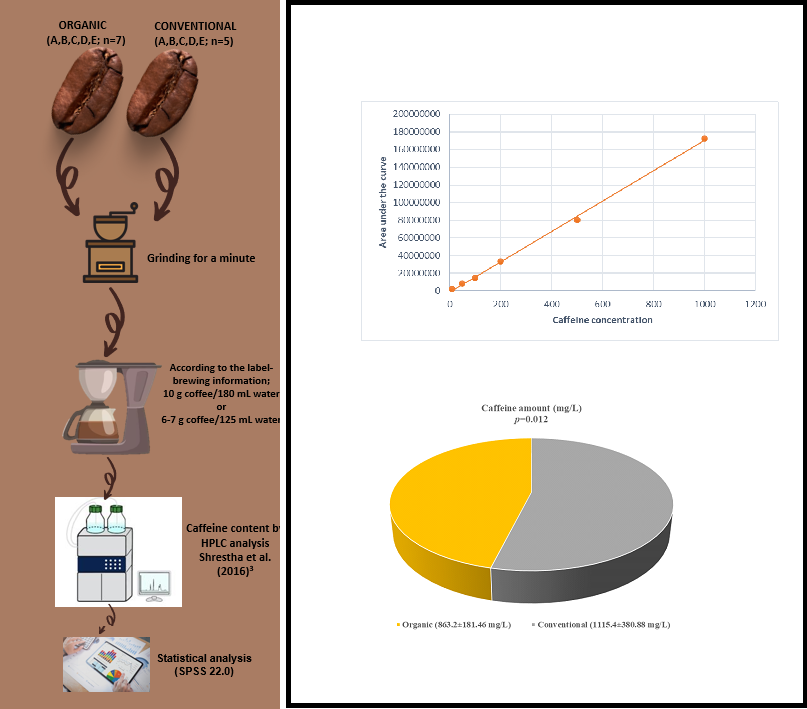JOURNAL 2780
Records of Agricultural and Food Chemistry
Year: 2023 Issue: 1 January-June
p.14 - 20
Viewed 1786 times.
-
Gülsüm Deveci

-
Elif Çelik

-
Özge Cemali

-
Teslime Özge Şahin

-
Ayşe Derya Bayazıt

-
Sena Özbay

-
Duygu Ağagündüz

-
Makbule Gezmen Karadağ

GRAPHICAL ABSTRACT

ABSTRACT
Organic farming is a controlled and certified form of agricultural production at every stage, from production to consumption, without using chemical inputs in production. It has been suggested that there are differences in the amount of nutrients and non-nutrient compounds in foods produced by organic and conventional agriculture. In light of this information, the caffeine content of coffee, which is an important consumption product in our country and the world, has been evaluated in terms of organic and conventional coffees. For this purpose, 12 different types of organic (n=7) and conventional (n=5) coffees belonging to 5 different brands (A, B, C, D, E) offered for sale in the market were included in the sampling. The included brands were carefully selected to provide both organic and conventional options. The caffeine content of all ready-to-serve coffee samples was analyzed with high-pressure liquid chromatography (HPLC). The caffeine content of the coffees was expressed as mg/L, and the statistical analysis of the data was done with the SPSS 22.0 package program. The amount of caffeine (mg/L) in organic coffees was therefore found to be lower than that in conventional coffees when coffees are compared based on production methods (863.2181.46 mg/L, 1115.4380.88 mg/L, p<0.05, respectively). While the quantity of caffeine in organic coffee from three brands was found to be lower than that of conventional coffee (Organic and conventional, respectively; A: 694.9±31.73 mg/L and 1030.8±7.55 mg/L; D: 853.9±32.50 mg/L and 1576.4±250.94 mg /L; E: 1094.2±32.03 mg/L and 1470.7±13.45 mg/L; p<0.05), it was found that the converse was true for the other two brands when the amount of caffeine is compared according to both the production method and the brands (Organic and conventional, respectively; B: 904.9±189.54 mg/L and 831.3± 67.91 mg/L, C: 684.4±63.78 mg/L and 667.7±84.36 mg/L; p<0.05). The amount of caffeine in the coffees acquired using the conventional production method was higher than the coffee obtained using the organic production technique, and the amounts of caffeine in the coffees varied depending on the brands. This integrates the fact that the amount of caffeine in food can depend on whether or not production
KEYWORDS- Caffeine
- Organic coffee
- Conventional coffee
- HPLC analysis